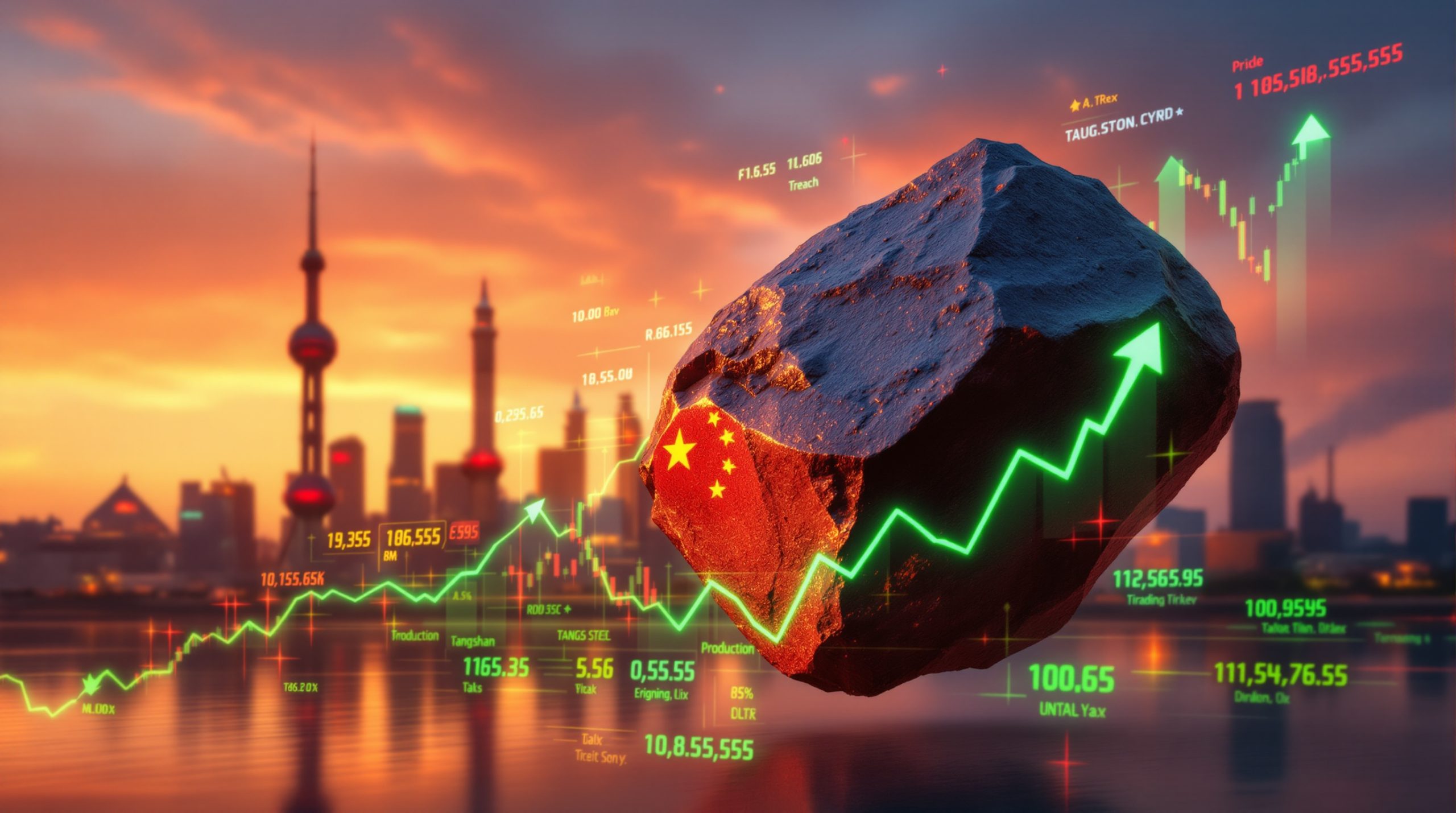REA's Strategic Push for Heavy Rare Earth Supply: US-Brazil Initiative
Rare Earths Americas (REA) has emerged as a significant player in the critical minerals sector, launching a strategic platform focused on developing high-grade heavy rare earth resources across the United States and Brazil. With substantial private funding and a portfolio of promising assets, REA aims to address growing demand for these essential materials in various high-tech industries.
The Formation of a New Rare Earth Powerhouse
Recently established with AUS$25 million (approximately US$16 million) in private funding, REA represents a focused effort to develop high-grade heavy rare earth mineral assets across two continents. The company has assembled a team of experienced operators and investors with expertise spanning global mining, energy, and critical minerals energy transition.
As Donald Swartz, CEO of Rare Earths Americas, explains: "The rare earths market is undergoing a generational shift as the West races to secure its rare earths future. With grade and strategic geography on our side, we intend to advance our rare earths projects to support the long-term supply of critical materials essential to domestic innovation."
The Critical Timing of REA's Market Entry
REA's emergence comes during a period of significant disruption in traditional rare earth supply chains. The company is strategically positioning itself to capitalize on Western nations' increasing efforts to secure alternative supply sources outside of traditionally dominant markets.
This timing aligns with growing demand from energy, defense, and robotics sectors—all of which depend heavily on rare earth elements for advanced components and systems. The company's dual-country approach provides a unique advantage in addressing these market needs.
What Assets Does REA's Portfolio Include?
REA has assembled a diverse portfolio of rare earth assets across the United States and Brazil, each with distinct characteristics and development potential.
The Foothills Project (United States)
The Foothills Project represents a new rare earth district discovery with exceptional grades measuring up to 41.3% Total Rare Earth Oxides (TREO). This grade significantly exceeds typical rare earth deposits globally, making it a potentially transformative asset.
Key advantages of the Foothills Project include:
- High concentration of heavy rare earth elements critical for high-performance magnets
- Strategic location on private land with outstanding logistics
- Access to low-cost power infrastructure
- Streamlined permitting process compared to projects on federal land
These factors could potentially accelerate development timelines and reduce regulatory hurdles compared to many competing projects.
The Brazilian Ionic Clay Projects
REA's Alpha and Constellation Projects in Brazil feature over 1 billion tonnes of high-grade ionic clay rare earth mineralisation. These deposits are particularly rich in heavy rare earths, including dysprosium and terbium—elements crucial for manufacturing high-performance permanent magnets.
Ionic clay deposits offer several advantages:
- Typically lower processing costs than hard-rock deposits
- Potential for environmentally friendlier extraction methods
- Generally simpler metallurgical requirements
- Significant scale potential compared to many global competitors
These factors position the Brazilian assets as potentially valuable components of REA's development strategy.
The Homer Project (Brazil)
The Homer Project consists of multiple large carbonatite clusters with significant exploration potential for rare earths and niobium. Located in a premium niobium-producing region, this early-stage project adds diversity to REA's portfolio.
While still in exploratory phases, carbonatite deposits are known globally as important sources of rare earth elements and other critical minerals. The project's location in an established mining region provides infrastructure advantages that could benefit future development.
Why Are Heavy Rare Earths Strategically Important?
The Critical Role in Modern Technology
Heavy rare earth elements play an essential role in numerous advanced technologies that underpin modern economies. Unlike their lighter counterparts, heavy rare earths possess unique magnetic and electronic properties that make them irreplaceable in certain applications.
These elements serve as crucial components in:
- High-performance permanent magnets used in electric vehicle motors
- Wind turbine generators for renewable energy production
- Advanced defense systems including guidance technology
- Precision robotics and automation equipment
- Medical imaging technologies
The unique properties of elements like dysprosium and terbium allow for the creation of magnets that maintain performance at high temperatures—a critical requirement for many advanced applications.
The Geopolitical Significance
The current global market for heavy rare earths is characterized by limited supply sources, creating strategic vulnerabilities for industries and nations dependent on these materials. This concentration has prompted Western nations to actively seek supply chain diversification.
Recent years have seen growing recognition of rare earths as critical to national security, leading to:
- Increased government support for domestic rare earth development
- Strategic partnerships between allied nations to secure supplies
- Investment in research for recycling and alternative materials
- Policy initiatives to reduce dependency on dominant suppliers
REA's development strategy aligns with these trends, potentially positioning the company to benefit from increasing governmental and industrial focus on supply chain security.
How Does REA Plan to Develop These Resources?
The Development Roadmap
While specific development timelines have not been publicly detailed, REA's approach appears to involve a phased exploration and development strategy across its multiple assets. The company will likely prioritize projects based on factors including grade quality, accessibility, and permitting requirements.
The Foothills project may see accelerated development due to its private land status, which typically involves fewer regulatory hurdles than projects on federal lands. Similarly, the Brazilian assets may benefit from the country's established mining framework and experience with rare earth development.
Potential development phases might include:
- Advanced exploration and resource definition
- Preliminary economic assessments and feasibility studies
- Environmental permitting and stakeholder engagement
- Construction and commissioning
- Production ramp-up and optimization
Technological and Processing Considerations
Processing represents one of the most significant challenges in rare earth development. REA will need to evaluate various extraction and separation technologies depending on the mineralogy of each deposit.
For the Brazilian ionic clay deposits, the company may explore environmentally responsible extraction methods such as:
- In-situ recovery techniques that minimize surface disturbance
- Processing methods that reduce chemical usage and waste generation
- Water management systems to minimize environmental impact
For hard-rock deposits, more conventional processing routes may be required, potentially including:
- Physical concentration methods (crushing, grinding, magnetic separation)
- Chemical leaching processes
- Solvent extraction for rare earth separation
- Product refining and purification
Strategic partnerships for downstream processing could also play a role in REA's development strategy, potentially reducing capital requirements while securing market access.
What Market Opportunities Is REA Targeting?
The Growing Demand Landscape
REA appears positioned to target multiple expanding market segments for rare earth materials. The global transition to renewable energy and electrified transportation is driving significant growth in demand for high-performance magnets containing heavy rare earths.
Key growth markets include:
- Electric vehicle motors requiring temperature-resistant magnets
- Wind turbine generators for renewable energy production
- Defense applications requiring secure supply chains
- Robotics and automation technologies
- Consumer electronics with miniaturized components
The focus on heavy rare earths specifically targets the highest-value segment of the rare earth market, where supply constraints are most acute and alternatives most difficult to develop.
Competitive Positioning Analysis
REA's competitive positioning appears to rest on several potential advantages:
- Exceptional grades at the Foothills Project compared to many existing operations
- Geographic diversification across two continents, reducing country-specific risks
- Strategic locations in mining-friendly jurisdictions with established frameworks
- Potential for expedited development timelines, particularly on private lands
These factors could provide significant advantages in a competitive marketplace where quality, reliability, and development speed are increasingly valued by potential customers.
What Challenges Must REA Navigate?
Technical and Operational Considerations
Despite its promising assets, REA faces several technical and operational challenges common to rare earth development projects:
- Processing complexity for different rare earth mineralizations, requiring tailored approaches
- Substantial capital requirements for development across multiple projects
- Need for specialized technical expertise in rare earth extraction and separation
- Balancing development priorities across a diverse asset portfolio
The company will need to address these challenges through strategic partnerships, capital raising, and recruitment of specialized talent as projects advance.
Market and Regulatory Factors
Beyond technical considerations, REA must navigate a complex landscape of market and regulatory factors:
- Evolving regulatory frameworks for critical minerals in both the US and Brazil
- Price volatility in rare earth markets, influenced by global supply-demand dynamics
- Competition from established producers with existing customer relationships
- Need to secure offtake agreements and strategic partnerships to support financing
The company's ability to navigate these factors will significantly influence development timelines and ultimate commercial success.
What Makes REA's Approach Distinctive?
The Dual-Country Strategy
REA's approach of developing assets across both the United States and Brazil represents a distinctive strategy in the rare earth sector. This approach offers several potential advantages:
- Leveraging regulatory and operational advantages in both countries
- Geographic risk diversification across two continents
- Ability to prioritize development based on changing market conditions
- Potential for complementary development timelines that smooth capital requirements
This multi-jurisdiction approach differs from many competitors focused on single-country development strategies.
The Focus on Heavy Rare Earths
REA's strategic focus on heavy rare earths targets the highest-value segments of the rare earth market. This specialized approach offers several advantages:
- Targeting elements with the most severe supply constraints globally
- Alignment with critical needs of high-tech manufacturing sectors
- Potential for premium pricing compared to light rare earth elements
- Positioning for increasing strategic importance in defence critical materials strategy
By focusing on these higher-value elements rather than the full rare earth spectrum, REA may be able to maximize economic returns while addressing critical supply chain vulnerabilities.
FAQ: Understanding REA's Rare Earth Initiative
What are heavy rare earth elements and why are they valuable?
Heavy rare earth elements (HREEs) are a subset of the 17 rare earth elements, distinguished from light rare earths by their atomic weight and properties. Elements like dysprosium, terbium, and yttrium fall into this category.
These elements are particularly valuable because:
- They possess unique magnetic properties essential for high-temperature applications
- Global supply is significantly more concentrated than for light rare earths
- They typically command higher prices due to supply constraints
- Few viable substitutes exist for their functions in critical technologies
- Processing complexities make new sources difficult to develop quickly
Their essential role in defense and renewable energy technologies further enhances their strategic importance beyond pure economic considerations.
How does REA's grade compare to other rare earth projects globally?
The reported 41.3% TREO grade at REA's Foothills Project represents an exceptionally high concentration compared to most operating rare earth mines globally. For context:
- Many operating rare earth mines work with grades of 1-10% TREO
- Even "high-grade" deposits typically fall below 15% TREO
- The heavy rare earth content percentage within this total grade is particularly significant
- Higher grades generally correlate with improved project economics
This exceptional grade could potentially translate to lower mining costs per unit of production, though processing costs often dominate rare earth project economics regardless of grade.
What timeline can investors expect for project development?
While specific timelines have not been publicly detailed, rare earth projects typically follow development pathways that include:
Exploration and Resource Definition Phase:
- Detailed drilling and sampling programs
- Resource modeling and classification
- Preliminary metallurgical testing
Permitting and Regulatory Approval:
- Environmental impact assessments
- Community consultation processes
- Regulatory applications and approvals
Construction and Development:
- Detailed engineering and design
- Construction of mining and processing facilities
- Commissioning and ramp-up activities
The timeline for these phases varies significantly based on jurisdiction, project complexity, and financing availability. Private land projects in the US may advance more quickly than those on federal lands, while Brazilian development timelines will depend on local regulatory processes.
How might geopolitical factors influence REA's development strategy?
Geopolitical considerations are likely to significantly influence REA's development strategy given the strategic nature of rare earth elements:
- Government critical minerals initiatives in both the US and Brazil could accelerate permitting or provide funding support
- Strategic partnerships or offtake agreements with defense contractors or technology manufacturers might emerge
- Changing trade policies and restrictions could impact market access and pricing
- Supply chain diversification efforts by Western nations may create preferential market opportunities
As global tensions around critical mineral supply chains continue to evolve, REA's dual-country approach provides flexibility to adapt to changing geopolitical realities while implementing mining industry innovation to overcome technical challenges. For companies looking to invest in this sector, understanding the potential of different deposits is crucial, which is why a comprehensive mineral deposit guide can be invaluable.
Disclaimer: The rare earth market is subject to significant volatility and geopolitical influences. Any investment decisions should be based on thorough due diligence beyond the information presented here. Development timelines, economic projections, and market conditions for rare earth projects carry substantial uncertainty.
Eyeing the Next Big Rare Earth Discovery?
Stay ahead of significant mineral discoveries like REA's strategic rare earth projects with Discovery Alert's proprietary Discovery IQ model, delivering instant notifications on ASX announcements with major market potential. Explore historic examples of exceptional investment returns from major discoveries at Discovery Alert's discoveries page and position yourself to capitalise on the next market-moving mineral find.




